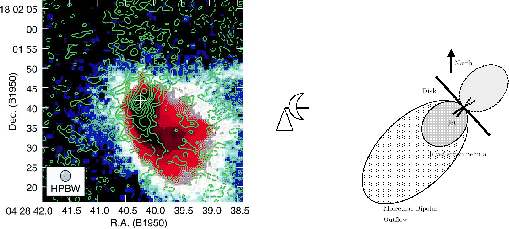Next: Infall Motion Up: Protostars Previous: B335 Contents
 |
L1551 IRS 5 is one of the most well studied protostellar objects. This has an infra-red emission nebulosity (Fig.1.14). It is believed that there is a hole perpendicular to the high-density disk and the emission from the central star escapes through the hole and irradiate the nebulosity. In this sense this is a reflection nebula. L1551 IRS 5 has an elongated structure of dense gas similar to that observed in B335. The gas is extending in the direction from north-west to south-east [Fig.1.14 (left)]. Since the opposite side of the nebulosity is not observed, the opposite side of nebulosity seems to be located beyond the high-density disk and be obscured by the disk. This is possible if we see the south surface of the high-density disk as in Figure 1.14 (right).